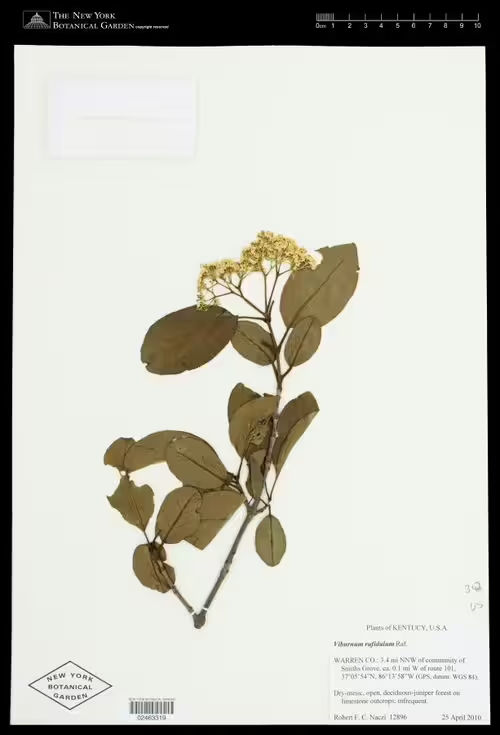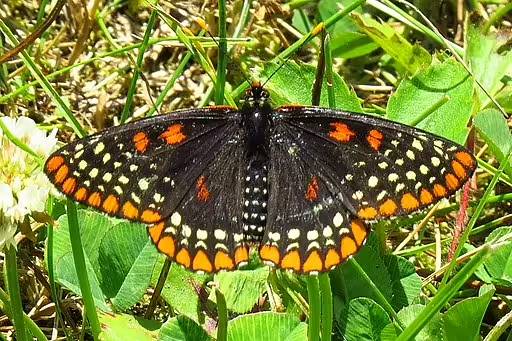Table of Contents for Rusty Blackhaw (Viburnum rufidulum)
Rusty Blackhaw (Viburnum rufidulum) is a shrub that is native to the mid-western, south-central, and eastern United States. This species is a host to the holly blue (Celastrina argiolus), Spring Azure (Celastrina ladon), Henry’s elfin (Incisalia henrici) and the baltimore checkerspot (Euphydryas phaeton). Growing from 6 feet to 20 feet tall, this species grows in shrub swamps, low woods, streambanks, roadsides, fields, and swamps. The white flowers bloom from April to May and the plant is hardy in zones 5-9.
Taxonomy and Naming of Rusty Blackhaw (Viburnum rufidulum)

Taxonomy
Rusty Blackhaw (Viburnum rufidulum) was originally named and described by Constantine Samuel Rafinesque in 1838. It has kept this same name since and is a member of the Muskroot Family (Adoxaceae).
Meaning of the Scientific and Common Names
Scientific Name
The genus name, Viburnum, derives from the Latin word for obscure or wayfaringtree. The species name, rufidulum, is a Latin for rusty colored, referring to the hue of the leaves.
Common Name and Alternative Names
The common name comes from the rusty hue of the leaves. Another common name is southern blackhaw (Goodrich 1963) and Alisier (McAtee 1937).
Physical Description

- Plant Type: This plant is a shrub.
- Height: 6 ft (1.8 m) to 20 ft (6.1 m) or to 40 ft (12.2 m) (Arnold Arboretum (1923)
- Stem: The stems are erect with dark brown to gray bark. The stems are pubescent with rusty brown hairs (NC Extension Gardener).
- Leaves: The leaves are simple, opposite, elliptical, obovate to ovate, and have serrate margins. They are 1 in (2.5 cm) to 3 in (7.6 cm) long and 2 in (5 cm) to 4 in (10 cm) wide. The leaves have rusty brown hairs on the underside giving it a reddish hue (NC Extension Gardener).
- Flower color: white to cream
- Blooming period: This plant blooms from April to May.
- Fruiting type and period: This plant has red to blue drupes that mature in the late summer to fall.
Range of Rusty Blackhaw in the United States and Canada

This Viburnum is native to the mid-western, south-central, and eastern United States. It is considered to be rare in the state of Ohio.
Habitat

This species grows in rocky or dry woods, floodplains and glades (Steyermark 1940), limestone (Thompson, et al 2005), cedar barrens (Carr 1944), oak-hickory woodlands (Wofford, et al 1979), calcareous prairies (MacRoberts and MacRoberts 1996), sandstone glades (Hays 1995), xeric sandhills (MacRoberts and MacRoberts 1995), disturbed habitats (Clark and Bauer 2001), and thickets (Missouri Botanical Garden).
Hosted Insects

This viburnum is a host to the holly blue (Celastrina argiolus), spring azure (Celastrina ladon), Henry’s elfin (Incisalia henrici), the Baltimore checkerspot (Euphydryas phaeton), and the scarce fritillary (Euphydryas maturna).
Other Supported Wildlife

This species is a nectar source to other butterflies, skippers, bees, and wasps during the growing season. Birds enjoy the fruits in the fall.
Frequently Asked Questions
Does this plant have any ethnobotanical uses?
The Native American Ethnobotany Database does not list this species specifically, but a number of other viburnums have been used for pharmaceutical purposes.
How is this plant distinguished from other Viburnums?
This species is most similar to smooth blackhaw (Viburnum prunifolium), but differs in that this species has herbaceous leaves that are green and the rusty blackhaw has coriaceous (leathery) leaves with a reddish hue to them (Weakley 2022).
Is this plant invasive?
This species has not been noted as being weedy.
Gardening with Rusty Blackhaw

observed in United States of America by Jen (licensed under CC0 1.0)
Hardiness
This species is hardy in zones 5-9. If your garden is within these zones and you have the right growing conditions (soil, moisture and exposure), you may well be able to grow this plant. However, if planted outside of its range, the hosted species may not recognize the plant or be harmed by ingesting a different species with an unfamiliar chemical composition.
Optimal Conditions
This species requires full sun to part-shade and dry to medium well-drained soils. This plant can handle poor soils, which makes it versatile in most planting situations.
Other Things of Note
This shrub has deep red foliage in the fall (Goodrich 1973).
References
- Arnold Arboretum. 1923. Arborescent Viburnums. Bulletin of Popular Information 9 (8): 30-31.
- Carr, Lloyd G. 1944. A New Species of Houstonia from the Cedar Barrens of Lee County, Virginia. Rhodora 46: 306-310.
- Clark, Ross C. and Ryan M. Bauer. 2001. Woody Plants of Six Northern Kentucky Counties. Journal of the Kentucky Academy of Science 62 (1): 39-51.
- Goodrich, Ross. 1973. Fall color in Southern California. Lasca Leaves 23: 107-109.
- Goodrich, Ross. 1963. Viburnum rufidulum. Lasca Leaves. 13: 24.
- Hays, John. 1995. A floristic survey of Falls Hollow sandstone glades, Pulaski County, Missouri. Phtyologia 78: 264-276.
- McAtee, W.L. 1937. Some local names of plants – VI. Torreya 37 (5): 93-103.
- MacRoberts, Barbara R. and Michael H. MacRoberts. 1996. The floristics of calcareous prairies on the Kisatchie National Forest, Louisiana. Phytologia 81: 35-43.
- MacRoberts, Barbara R. and Michael H. MacRoberts. 1995. Floristics of xeric sandhills in Northwestern Louisiana. Phytologia 79: 123-131.
- Steyermark, Julian. 1940. Studies of the vegetation of Missouri – I. Natural Plant Associations and Succession in the Ozarks of Missouri. Botanical Series Field Museum of Natural History 9 (5). Publication 485.
- Thompson, Ralph L., J. Richard Abbott, Andrew E. Shupe. 2005. Vascular Flora from Five Plant Habitats of an Abandoned Limestone Quarry in Clark County, Kentucky. Journal of the Kentucky Academy of Science 66 (1): 24-34.
- Weakley, A.S. and Southeastern Flora Team. 2022. Flora of the southeastern United States. University of North Carolina Herbarium, North Carolina Botanical Garden.
- Wofford, Eugene B., Thomas S. Patrick, Loy R. Phillippe, David H. Webb. 1979. The Vascular Flora of Savage Gulf, Tennessee. Sida 8: 135-151.


